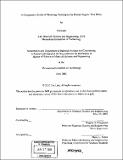A comparative study of metrology techniques for porous organic thin films
Author(s)
Lam, Yee, 1979-
DownloadFull printable version (3.328Mb)
Other Contributors
Massachusetts Institute of Technology. Dept. of Materials Science and Engineering.
Advisor
Eugene A. Fitzgerald.
Terms of use
Metadata
Show full item recordAbstract
With the development of porous materials for use as dielectrics in microelectronics processing, appropriate metrology tools are needed to monitor and characterize the pore size, distribution, and percent porosity in these films in an industrial setting. Techniques used to characterize and monitor porosity in thin films are oftentimes destructive, such as Transmission Electroil Microscopy and Scanning Electron Microscopy; indirect, such as optical ellipsometry and X-Ray Reflectivity; or pose problems for industrial use, involving radioactivity such as Positronium Annihilation Lifetime Spectroscopy and Small Angle Neutron Scattering. Atomic Force Microscopy is limited to surface analysis, and pores may be intersecting the surface at a variety of chords, not necessarily the diameter. Each of these techniques also has unique advantages, and a combination of these techniques can compensate for limitations such as inability to detect closed pores or constraints on pore size range of measurement. The following study is a round robin evaluation of these techniques using Developmental (Version 7) Porous SiLK(TM) from DOW Chemical (Midland, MI) manipulated to create pores of varying sizes. Optical tools and a possible in line X-Ray Reflectivity tool were found to be optimal for implementing porosity characterization in industry, since both techniques are commercially available, have proven high throughput, and can be clearly correlated to pore size and porosity in organic thin films.
Description
Thesis (S.M.)--Massachusetts Institute of Technology, Dept. of Materials Science and Engineering, 2002. Includes bibliographical references (leaves 38-39).
Date issued
2002Department
Massachusetts Institute of Technology. Department of Materials Science and EngineeringPublisher
Massachusetts Institute of Technology
Keywords
Materials Science and Engineering.